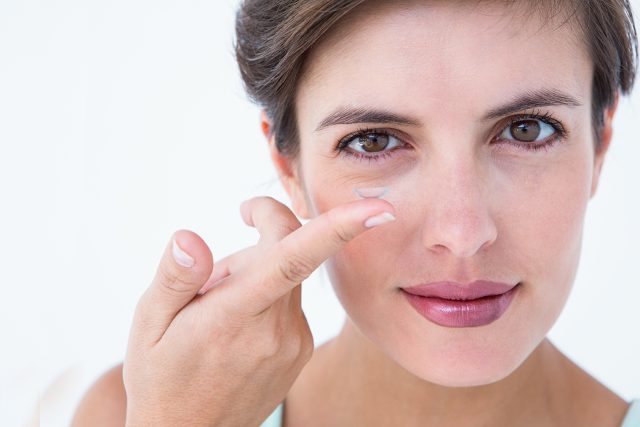What is Keratoconus?
Keratoconus is a condition where the cornea (the front part of the eye), bulges out or protrudes. Kera, the first part of the term Keratoconus, means cornea. The second part of the term, “Conus” means “cone”, as in an ice-cream cone. That describes the shape of the cornea.
The cornea is the front part or “cover” to the eye. It is the first and most important surface when light enters into the eye to travel to the back of the eye where it reaches the retina. The retina turns light into brain impulse and sends it to the brain.
When someone has keratoconus, the cornea becomes thin and then protrudes, causing a steep shape in the center of the cornea. Vision becomes worse depending on the amount of cornea that is affected. There can be scarring (clouding) of the cornea which further makes it difficult to see.
In keratoconus, the normally round shaped cornea becomes thin and begins to bulge into a cone-like shape. This often begins when someone is in their teens or 20’s. As light passes through the cornea, it no longer reaches the retina clearly. Rather, it is distorted and causes distorted vision. Keratoconus can occur in either one eye or in both eyes.
Diagnosing Keratoconus
Keratoconus can be difficult to detect. We use a special instrument called a topographer, that measure 8000 points on the cornea and gives us an exact map of the “fingerprint” unique shape of the eye.
As the cornea becomes more irregular in shape, it causes the individual to become more and more nearsighted. Nearsighted means that someone can see at near, and will see blurry at distance. Other symptoms include sensitive to glare and light. Eyeglass prescriptions change rapidly. The diagnosis of Keratoconus is commonly missed if the practitioner is unfamiliar with the early-stage symptoms of the disease.
Early symptoms of Keratoconus include frequent changes in eyeglass prescription as the individual becomes more nearsighted and has greater astigmatism (irregular curvature between the vertical [up and down] and horizontal [side to side]. It can also cause someone to be more sensitive to glare and to light
Corneal Topography is tested using a special test instrument that measures thousands of different points on the cornea and enables the doctor to see the precise shape of the cornea. A land topography map tells us about land elevations and depressions; essentially hills and valleys. The corneal topographer, an instrument that we have in our office, enables us to get a "map" of your cornea and enables us to make a contact lens to the precise shape of the cornea.
When does Keratoconus Usually Manifest?
Keratoconus usually begins during the teenage years or early 20s. The most likely reason for keratoconus is genetic. If affects both girls and boys and may be greater in one eye than the other. Keratoconus affects about I person in every 2000-3000.
As the condition worsens, there is more distortion in the cornea, and a special gas permeable contact lens can usually restore vision. Fortunately, keratoconus rarely causes blindness. There is usually a high amount of astigmatism. Special contact lenses specifically designed for keratoconus can reduce the need for a corneal transplant. Customized lenses are made specifically for that cornea, and this means better comfort and clarity. At times, a soft lens can be used to restore sight. At times, lenses may need to be changed if the keratoconus continues and the cornea becomes steeper. This is why they must be re-assessed each year.
Treating Keratoconus
Prescribing contact lenses for someone with Keratoconus is challenging and time-consuming. With our topographer and a special computer program where we can make a customized lens, the outcomes are often astounding. The following are some of the specialty contact solutions we employ to effectively treat keratoconus.
Gas Permeable Contact Lenses
In the mildest form of Keratoconus, eyeglasses or soft contact lenses may help. As the disease worsens, the cornea thins and becomes increasingly more irregular in shape. Glasses and soft contacts may no longer provide adequate vision correction. The preferred treatment for moderate and advanced Keratoconus is Gas Permeable contact lenses. Scleral lenses are now often used. GP lenses are made of a specific lens material that enables people to see clearest because it replacing the irregular shape of the cornea, with a smooth, uniform refracting surface that then improves vision.
Sensitivity to Light and Scarring
Sensitivity to light (photophobia) occurs when lenses either move too much on the cornea. This can cause scarring. Rarely, but at times, we must use a soft lens as a bandage and a gas permeable lens on top of that. This “piggyback” combination usually lasts only for a short time until the cornea heals. The new measurements are taken and new lenses are designed.
Scleral Lenses
Special Scleral Lenses are used for The Treatment of Advanced Keratoconus, Pellucid Marginal Degeneration, and Post-Lasik Ectasia. Scleral lenses vault over the center of the cornea and do not touch it. The lens sits on the white part of the eye that is called the sclera. The front surface of the eye is always in a liquid environment. Vision and comfort are almost always excellent.
These special Scleral Lenses are also used to help restore vision and comfort for those individuals who have had loss of vision due to Corneal Transplant Surgery or Refractive Surgeries such as Lasik, R-K, or PRK. They are also used when an eye has a chronic disease or has had trauma to the cornea.
These special lenses are easy to insert, remove and to clean. They provide excellent eye health and allow the cornea to “breath” oxygen directly through the lens.
The lens positions directly over the cone and do not slide on the cornea.
Special Scleral lenses and hybrid lenses (ClearKone) combine the benefit of a highly oxygen-permeable rigid center with a soft peripheral "skirt." ClearKone was designed specifically for Keratoconus and vaults above the eye's cone shape for increased comfort. The center part provides the crisp optics of a GP lens and outer soft skirt offers the benefit of the comfort one would typically get with a soft contact lens. They are available in a wide variety of parameters customized to provide a fit that conforms well to the irregular shape of a keratoconic eye.
Scleral and semi-scleral lenses is larger diameter lenses (about the size of a normal soft contact lens) made in gas permeable (GP) materials and are designed to rest on the white part of the eye (sclera). Scleral lenses cover a larger portion of the sclera, whereas semi-scleral lenses cover a smaller area. They vault over the irregularly shaped cornea and they feel more comfortable than prior designs. The Boston Scleral Lens Prosthetic Device (BSLPD) is a scleral lens that has been given a proprietary name.
Custom lenses prescribed in our office have resulted in very positive outcomes. They are done close to home and usually at considerably less cost.
People with severe dry eye also find relief when using scleral lenses.
Treatment for Severe Keratoconus
More drastic treatments of Keratoconus include:
- Corneal cross-linking is a non-invasive procedure that strengthens corneal tissue in an attempt to halt bulging of the eye's surface in Keratoconus. Corneal cross-linking also is being investigated as a way to treat or prevent keratoconus-like complications following LASIK or other vision correction surgery.
- Corneal transplant is sometimes needed if contact lenses are not tolerated and is a last resort. Another term for a cornea transplant is penetrating keratoplasty (PK or PKP). Even after a transplant, eyeglasses or contact lenses are needed for clear vision. Often, after Corneal Transplant, special lenses are needed to restore sight.
Often the causes of Keratoconus are less important than the treatment. Research suggests that the bonds that hold the corneal tissue together are lost because of an imbalance of enzymes within the cornea. This causes the cornea to bulge forward. Risk factors include: a history of family members with Keratoconus, excessive eye rubbing, overexposure to ultraviolet rays from the sun, a history of poorly fitted contact lenses and chronic eye irritation.




Appointment times may vary so call us for availability.